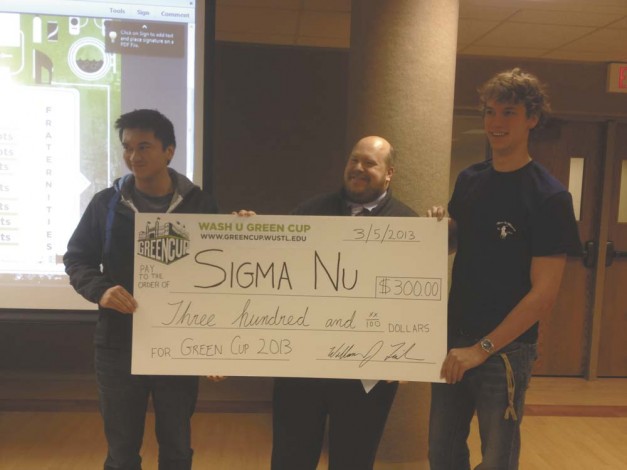Campus Events
Sigma Chi members shocked, disappointed by Green Cup second place
Students living in the Liggett-Koenig residential college pose for a photo after winning the South 40 Green Cup.
A cohort of around 10 members of the Sigma Chi fraternity expressed surprise and discontent when Justin Carroll, associate vice chancellor for students, announced their second-place finish in this year’s Green Cup competition with 24 points. Sigma Nu took the gold, scoring a total of 28 points.
The Green Cup is a month-long competition in which on-campus residential areas including the North Side, South 40 and fraternity houses compete in separate “leagues” to reduce their energy usage by the highest percentage. The competition began in 2011 with two leagues, the fraternities and the South 40.
At a Green Cup Awards Ceremony held Tuesday night at a Congress of the South 40 Assembly meeting, Director of Sustainability Phil Valko said that one kilowatt hour of energy is approximately equivalent to one pound of coal, which can power a copy machine for about half a day. While last year’s competition reduced consumption by about 40,000 pounds of coal, this year’s Green Cup reductions totaled nearly 140,000 pounds.
Sigma Chi, the fraternity league’s two-time winner and undefeated Green Cup champion, was beaten out by Sigma Nu not in overall energy reduction but because of extra points awarded for spirit activities including wearing the “Greenman suit,” making videos and collecting signatures for the Sustainability Pledge—a point for every 10 percent of the team that takes the pledge, up to 10 points.
Sigma Chi’s Green Cup representative, junior Lucas Tcheyan, said the house did not make efforts to earn extra points last year and did not think they would be necessary this year either.
“We basically have a system in our house where, once Green Cup kicks in, we turn off all energy…we turn of lights and consolidate fridges. We basically just try to keep consumption as low as possible,” Tcheyan said.
Each on-campus dorm, house or apartment’s energy reductions are monitored throughout the month of February with energy meters, installed in each of the on-campus facilities since last year. Total reduction was measured and reported to residents each week.
Tcheyan said that, since the Sigma Chi house had the highest recorded energy reductions each week, about four percent per week on average, he and other brothers in the house felt confident that they had secured a win for the third year in a row.
“We were [excited] because we did save the most energy every week, at least four percent each week, I think,” Tcheyan said.
Sustainability Coordinator Will Fischer met with representatives from each of the teams in January to review the points system from last year and solicit feedback or suggested changes. Once finalized, the scoring system was reviewed with each of the teams and posted on the Green Cup website.
“I’m surprised that there’s so much surprise and reaction to it because [information on the scoring system] has been out there the whole time,” Fischer said.
He said that the extra points could probably have been structured more fairly.
“Looking back, in hindsight, it does seem like it was a little too many points to award to a fraternity, given that in a 30-person fraternity [house], it’s pretty easy to get all 30 members to sign the Pledge to get ten points. It’s much more challenging to get 10 percent of a residential college to sign a pledge, or 100 percent,” Fischer said.
Still, Fischer said that extra points are designed to increase overall engagement in the competition, especially among the fraternities.
“Obviously, the most important thing to do is reduce energy consumption, but we want to also allow for other opportunities for teams to get engaged, have some Green Cup spirit and to get additional points,” he said.
Among the fraternities, cash prizes of $300, $200 and $100 are awarded to the first-, second- and third-place winners, respectively. This year’s third-place winner was Kappa Sigma.
“[Sigma Nu and Sigma Chi] were remarkably close, and that’s a pretty substantial amount of energy reduction. I mean, reducing by nearly a quarter is pretty substantial. So both of them, it appeared, were pretty engaged [with] the level of reducing energy,” Fischer said.
On the South 40, Liggett/Koenig took home the trophy, a Dough to Door cookie party and Residential College Olympics points, while second-place winners Lee/Beaumont and Rubelmann/Umrath/S40 House won root beer float parties and RCO points. William Greenleaf Eliot, JKL, Brookings and HIG will also receive RCO points.
During the competition last year, “live standings” of different buildings were available 24/7 on the Green Cup website. This year, new meters provided more accurate readings of energy reduction, but “live standings” were not possible.
“The negative of [the new meters] was that we couldn’t have those live standings, which makes it seem more like a sport, like more competitive, and so I think that was a little bit of an adjustment,” sophomore and CS40 Sustainability Chair Casey Weiss said. “But in the end…even though people may say there wasn’t as big of a hype about it [this year], we’re reducing more and more, and Wash. U. is becoming more and more environmentally conscious.”
She said that, while last year, Sigma Chi and Lee/Beau won by landslide victories, other teams became more engaged in the competition this year, both in spirit points and energy reduction.
On the North Side, the Village, which includes the Village House and Lopata House, triumphed over the Millbrook Apartments and Village East.


